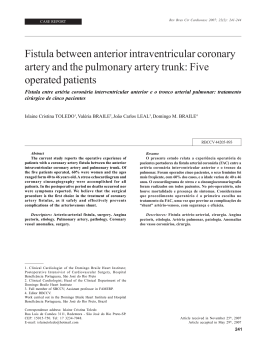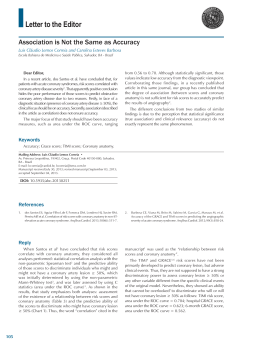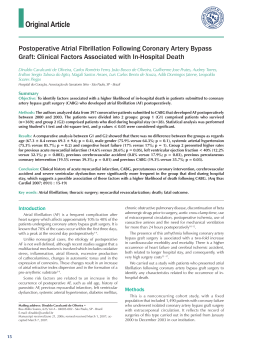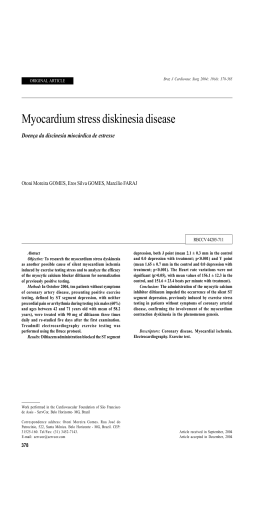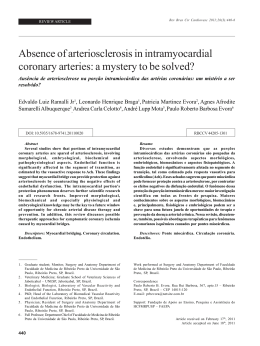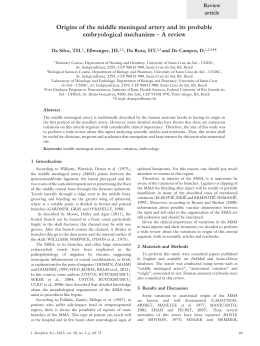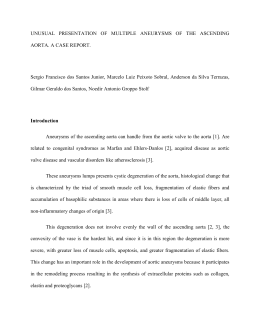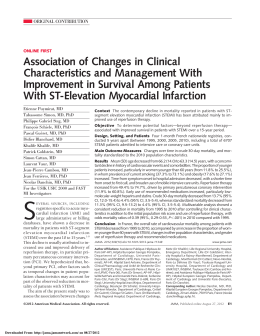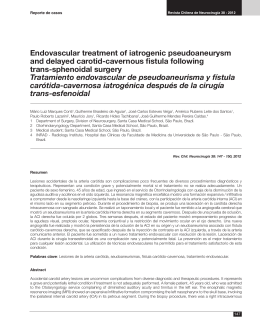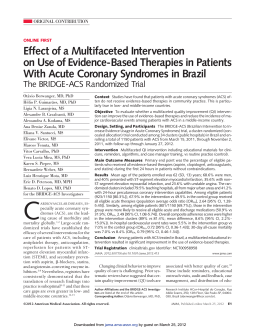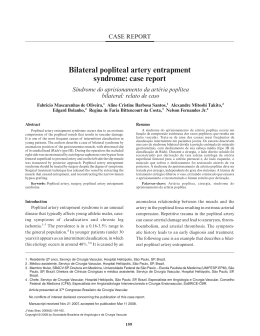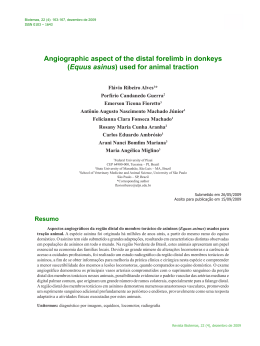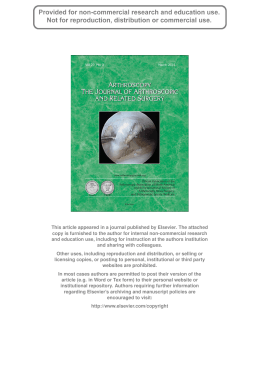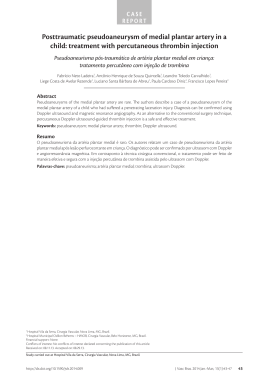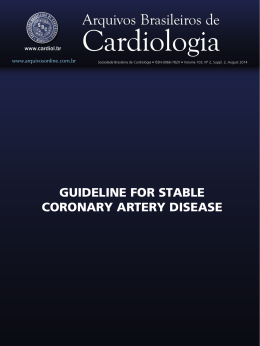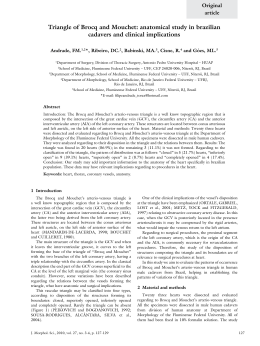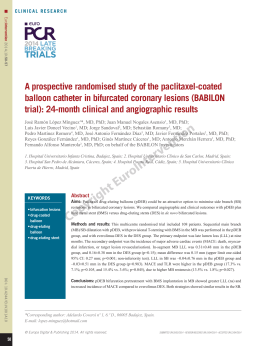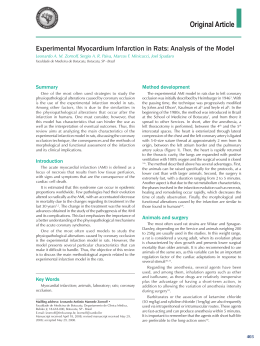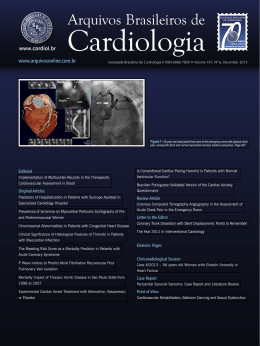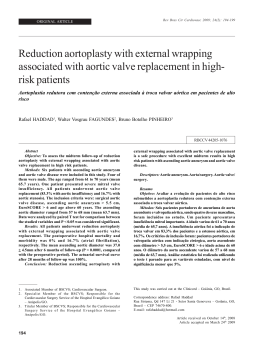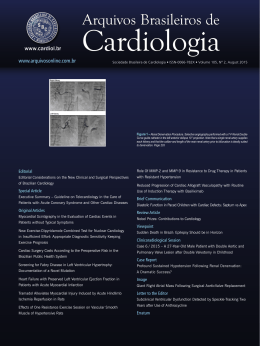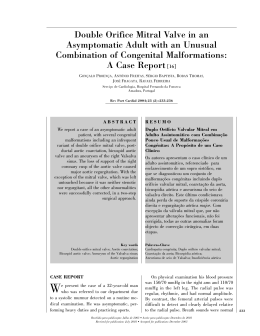CASE REPORT Rev Bras Cir Cardiovasc 2007; 22(4): 505-508 Myocardial revascularization in anomalous origin of the right coronary artery: case report Revascularização do miocárdio em origem anômala da artéria coronária direita: relato de caso Marcelo Sávio da Silva MARTINS1, Eduardo Sérgio BASTOS2, Jorge Viana ANNIBAL3, Alvaro Barde BEZERRA4 RBCCV 44205-937 Abstract A 21-year-old man with angina-like chest pain and syncope related to ischemic ECG changes due to an anomalous origin of the right coronary artery. The patient was submitted to surgical correction with myocardial revascularization with internal thoracic artery. A literature review of this rare congenital heart disease is presented. Resumo O objetivo deste artigo é mostrar o caso de um paciente de 21 anos com episódio de angina e lipotímia relacionados com alteração isquêmica do miocárdio decorrente de origem anômala da artéria coronária direita a partir do seio da aorta (seio de Valsalva) esquerdo. O paciente foi submetido à cirurgia de revascularização do miocárdio, com artéria torácica interna direita para artéria coronária direita. É realizada também uma revisão da literatura desta rara doença cardíaca congênita. Descriptors: Coronary vessel anomalies. Sinus of Valsalva. Coronary disease. Descritores: Anomalias dos vasos coronários. Seio aórtico. Coronariopatia. 1. Cardiovascular Surgery Specialist; Heart Surgeon, Hospital de Força Aérea do Galeão (HFAG). Postgraduate student, Departament of Surgery, Faculdade de Medicina da Universidade Federal do Rio de Janeiro. 2. Associate Professor, Departament of Surgery, Discipline of Heart Surgery, Faculdade de Medicina da Universidade Federal do Rio de Janeiro; Heart Surgeon, Heart Surgery Service, Universidade Federal do Rio de Janeiro, HFAG. 3. Head Clinical Surgeries, HFAG; Heart Surgeon, HFAG. 4. Director of Hospital de Aeronáutica de São Paulo; Heart Surgeon. This study was carried out at Hospital de Força Aérea do Galeão, RJ. Correspondence address: Marcelo Sávio da Silva Martins. Rua Ary Parreiras, 65/904, Icaraí, Niterói, RJ. CEP 24230-320. E-mail address: [email protected] Article received in 19 May 2007 Article accepted in 20 Jul 2007 505 MARTINS, MSS ET AL - Myocardial revascularization in anomalous origin of the right coronary artery: case report INTRODUCTION Right and left coronary arteries arise from the aortic sinus behind their respective semilunar cups. Usually, the ostia are localized in the superior third of aortic sinus (sinus of Valsalva). Because the oblique plane of aortic valve, left coronary (LC) artery ostium is superior to the right coronary (RC) artery ostium. Coronary artery abnormalities result from disorders occurring during fetal development and may present varying anatomic aspects according to their route and origin. These abnormalities without another congenital defect associated are rare and are identified only in 0.25% to 0.9% of the cineangioicoronariographies. Gender prevalence was not observed [1]. Among these abnormalities, the most frequent one is the anomalous origin of the circumflex branch of right coronary artery. It is described for the first time in the literature. Yet most unusual is the anomalous origin of the left coronary (LC) artery from the right coronary (RC) artery, i.e., the isolated origin of the posterior interventricular branch (posterior descending branch) of the left coronary artery [2]. The origin of the right coronary artery from the left aortic sinus corresponds to 16% of these anatomic variations. It was firstly described in 1984 by White et al.. It is a potential cause of sudden death in children and athletes due to myocardial ischemia, acute myocardial infarction (AMI) or sudden death [2]. The treatment is surgical and Bett performed the first surgical correction in 1985. Rev Bras Cir Cardiovasc 2007; 22(4): 505-508 The transesophageal echocardiogram was normal, with left ventricular global and segmental contractions preserved. Holter monitor showed ischemic alterations during maximum exertion. Transesophageal echocardiogram showed the anomalous right coronary artery pathway between the aorta and pulmonary trunk. Nuclear magnetic resonance (NMR) was not conclusive. Cineangiocoronariography showed a normal left coronary artery and the anomalous origin of the left coronary artery from the left aortic sinus (Figure 1), with a possible pathway between the aorta and pulmonary trunk. CASE REPORT Fig. 1 - Cineangiocoronariografia da CD A 21-year-old male athlete was asymptomatic until February 2003, when presented syncope as a result of physical activity. One month later, the patient presented a sharp precordial pain and lipothymia when walking. Patient was referred to the Hospital de Força Aé rea do Galeão (HFAG) emergency service, where on physical examination, he presented blood pressure of 190 x 120 mmHg. The patient was discharged from hospital after being treated with calcium channel blocker and once blood pressure was under control. A family history of sudden death was already established as a consequence of his 13-year-old brother’s sudden death with reports of precordial pain and cardiac murmur. In this case, the presence of cardiac murmur associated to precordial pain raises the possibility of the patient to present with a coronary fistula. After 30 days, the patient presented with the same symptoms and he received medical care at HFAG. At the time, he reported typical precordial pain and the electrocardiogram showed ischemic alterations. 506 Patient underwent myocardial revascularization with the right internal thoracic artery grafting the right coronary artery proximal segment and proximal ligation of RCA with a good postoperative outcome. In a new exercise test performed six months postoperatively, signs of myocardial ischemia were not noted even under extreme exertion. DISCUSSION This is an unusual anomaly and a potential cause of sudden death in children and athletes with the majority of the cases being reported by both pediatrician and mainly pathologist authors. In reviews of the current literature, it is more common to find reports of coronary fistula correction surgery due to cardiac murmur, what draws surgical attention leading to the performance of complementary tests that diagnose the anomaly [1]. MARTINS, MSS ET AL - Myocardial revascularization in anomalous origin of the right coronary artery: case report Rev Bras Cir Cardiovasc 2007; 22(4): 505-508 In the literature, the first case was published, in 1948, by White et al. in an autopsy finding [2]. In 1974, Cheitlin published a catheterization finding. In 1980, Benge et al. [2] presented the first publication addressing the morbidity of this coronary artery anomaly; however, only in 1985, the first surgical correction of the anomalous origin of right coronary artery from the left aortic sinus was performed by Bett, who used a saphenous vein graft [3]. In an analysis of 12,595 patients undergoing catheterization, coronary artery anomalies were found in 1,686 patients (1.3%). Of the 1,686 patients, 1,461 (87%) had anomalies of origin and distribution, and 225 (13%) had coronary artery fistulae. Among patients with anomalies of origin, 16% had right coronary origin from the left aortic sinus [4]. Regarding anomalies of origin, they can arise from abnormal origin in aortic sinus, from pulmonary trunk origin, or present a single ostium. These anomalies were classified as benign and malignant according to the symptoms presented. The benign anomalies do not result in signs, symptoms, or complications. The malignant anomalies carry a high risk of angina pectoris, syncope, acute myocardial infarction, congestive heart failure, and sudden death and require surgical correction. Among the so-called malignant anomalies, we can include ectopic coronary origin from the contralateral aortic sinus [4], similar to the case herein presented. The pathophysiology of myocardial ischemia (Figure 2) provoked by this anomaly is due to three causes resulting from right coronary artery pathway between the aorta and pulmonary trunk: 1. Slit-like ostium: because of the pressure put on this artery by the two large vessels, a hypertrophy of the tunica intima and a deformity of this coronary artery diameter occur; 2. Output angle, rather than perpendicular to the aorta, nearly forms a right angle with the aorta wall; 3. Systolic compression that is the most leading explanation for the etiology of sudden death among athletes occurring when there is an increased arterial pressure, what increases the aorta diameter and the pulmonary trunk as well, then occurring the right coronary artery segment collapse between both structures [3]. Many patients with anomalous coronaries are asymptomatic and signs of myocardial ischemia in youths are not valuable making difficult the diagnosis of this anomaly. Clinical complications occur usually during physical exertion evoked by the anomalous pathway of these arteries, especially in the pathway between the aorta and pulmonary trunk. Myocardial perfusion changes can occur as a consequence of the movements of the vessels during cardiac cycle. It is due to this physical exertion that acute myocardial infarction, or even ischemia-induced arrhythmias may occur [3]. Repair surgery can be performed by right coronary artery reimplantation, or using a graft for this coronary. On reimplantation, the artery is moved to its proximal portion and anastomosed to the right aortic sinus. However, in these cases, the coronary artery proximal segment, which is compressed between the aorta and pulmonary trunk, can present intimal hyperplasia, thus favoring thrombosis and the occurrence of local atherosclerosis [5,6]. The choice of surgical procedure was the use of right internal thoracic artery (RITA) grafted into the right coronary artery just after its emergence in the pathway between the aorta and pulmonary trunk, with ligation of proximal vessel. Fig. 2 - Compressão da CD entre aorta e o tronco pulmonar CONCLUSION In the anomalous origin of the right coronary artery from left aortic sinus, with a route between the aorta and pulmonary trunk, surgical anastomosis of right internal thoracic artery to the anomalous origin of the vessel and proximal ligation can be considered as a safe and easily reproducible technical option. 507 MARTINS, MSS ET AL - Myocardial revascularization in anomalous origin of the right coronary artery: case report REFERENCES 1. Cieslinski G, Rapprich B, Kober G. Coronary anomalies: incidence and importance. Clin Cardiol. 1993;16(10):711-5. Rev Bras Cir Cardiovasc 2007; 22(4): 505-508 4. Giroux SK, Cartier R. Atypical presentation of an anomalous origin of the right coronary artery with severe compression between the great vessels. Ann Thorac Surg. 2002;73(5):1636-8. 2. Benge W, Martins JB, Funk DC. Morbidity associated with anomalous origin of the right coronary artery from the left sinus of Valsalva. Am Heart J. 1980;99(1):96-100. 5. Di Lello F, Mnuk JF, Flemma RJ, Mullen DC. Successful coronary reimplantation for anomalous origin of the right coronary artery from the left sinus of Valsalva. J Thorac Cardiovasc Surg. 1991;102(3):455-6. 3. Yamanaka O, Hobbs RE. Coronary artery anomalies in 126,595 patients undergoing coronary arteriography. Cathet Cardiovasc Diagn. 1990;21(1):28-40. 6. Nelson-Piercy C, Rickards AF, Yacoub MH. Aberrant origin of the right coronary artery as a potencial cause of sudden death: successful anatomical correction. Br Heart J. 1990;64(3):208-10. 508
Download
